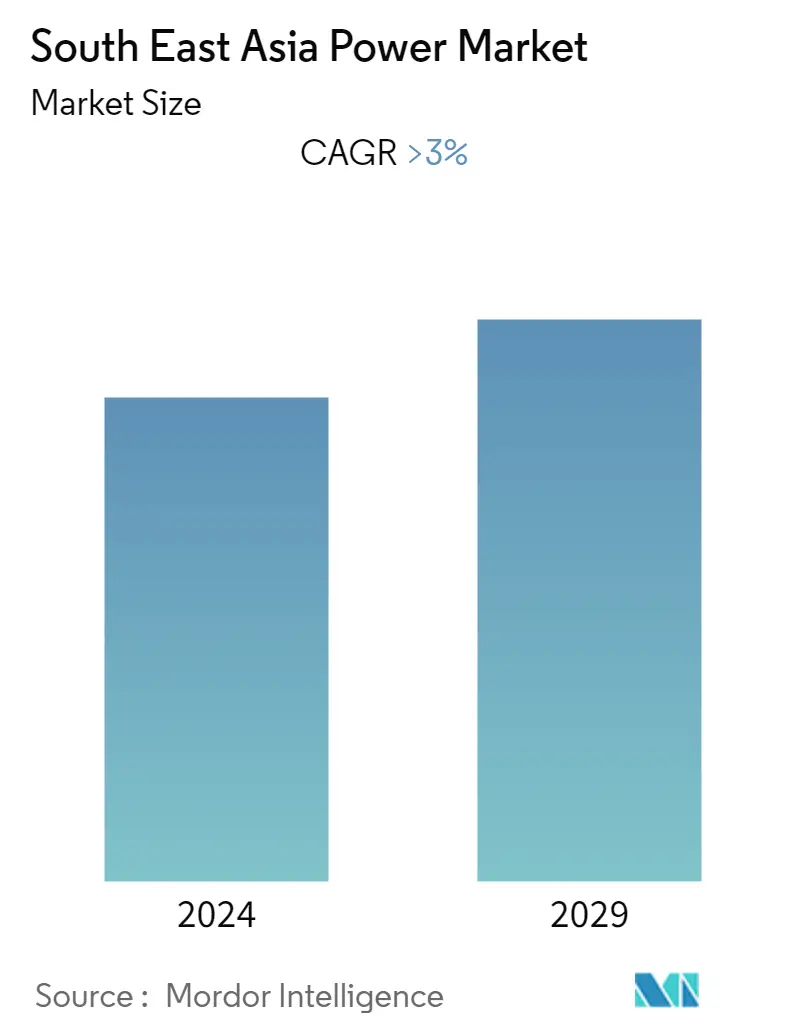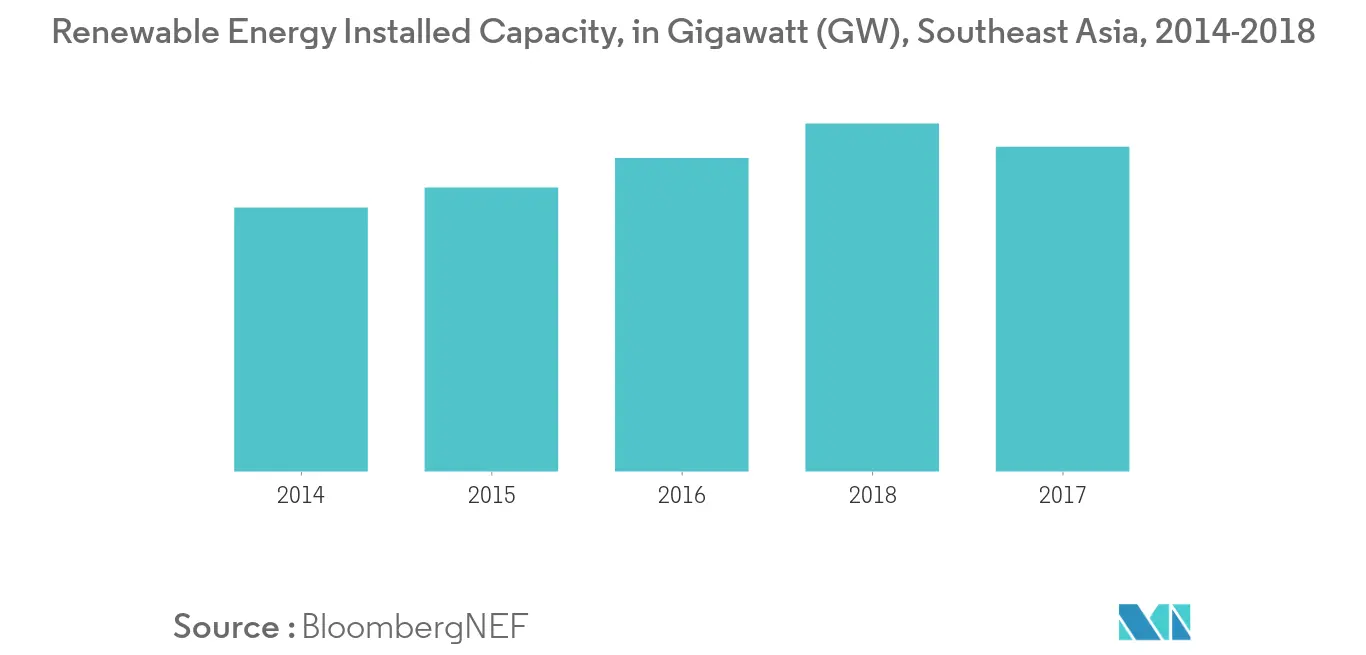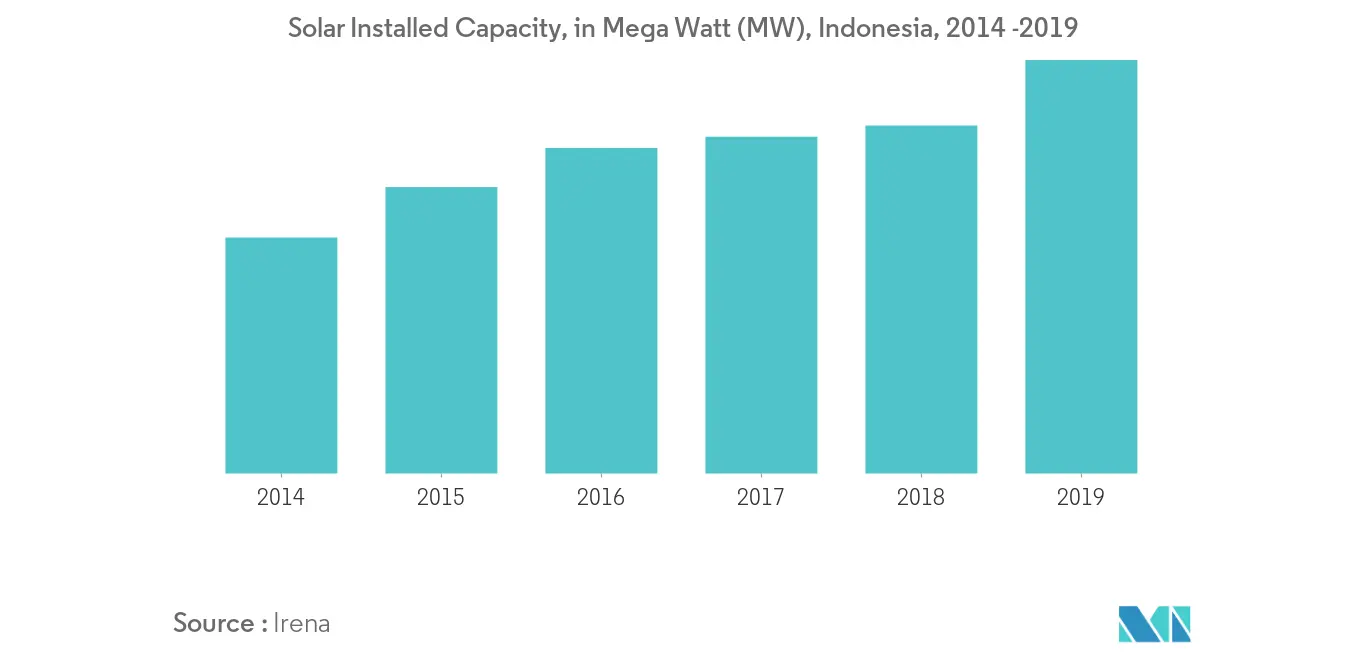South East Asia Power Market Size

| Study Period | 2020 - 2029 |
| Base Year For Estimation | 2023 |
| Forecast Data Period | 2024 - 2029 |
| Historical Data Period | 2020 - 2022 |
| CAGR | 3.00 % |
| Market Concentration | Low |
Major Players
*Disclaimer: Major Players sorted in no particular order |
Need a report that reflects how COVID-19 has impacted this market and its growth?
South East Asia Power Market Analysis
The South East Asia power market is expected to grow at a CAGR of over 3.0% in the forecast period of 2020-2025. Factor such as increasing demand for energy, governmental push towards the increase of renewables and reducing carbon emissions are expected to drive the market. However, a considerable investment that is required for setting up and modernizing of power generation, transmission or distribution network, and weak private sector investment are expected to impede the growth of the market.
- Renewable energy is expected to be the fastest-growing segment in the forecast period, with a large-scale increase in the solar and wind sector. Governmental push, negligible carbon emission, and the trend of reduction in the costs of generating electricity are expected to be the main drivers of the segment.
- New models of solar cells made of a thin film technology that uses thin coatings of cadmium telluride in solar cells, which has higher efficiency and lower cost, may prove to be an opportunity in the sector.
- Indonesia is the largest market in the region, owing to its large population and electricity generation capacity. An increase in the level of industrialization and rising urbanization in the country is expected to aid the growth in the market further.
South East Asia Power Market Trends
This section covers the major market trends shaping the South East Asia Power Market according to our research experts:
Renewable Energy Sector to be the Fastest-Growing Segment
- Renewable energy installed capacity in Southeast Asia, increased by 7.15%, to 68.24 Gigawatt, in 2018 from 63.68 Gigawatt, in 2017. The installed capacity is expected to increase in the forecast period and act as a driver to the market.
- In 2019, with nearly no solar capacity, Cambodia mooted an auction process that attracted 26 bidders, including international companies, and registered a record low bid for the Southeast Asian region at $38.77/MWh. With such a response to the auction, renewable energy is expected to increase in the forecast.
- In May 2020, Malaysia's Ministry of Energy and Natural Resources has announced the fourth round of the nation's Large-Scale Solar (LSS) procurement scheme. It has a tender to increase the installed capacity by 1 Gigawatt of electricity. The successful applicants are expected to have until the end of 2023 to get their plants connected to the grid.
- In Vietnam, the preferential taxation policy offers an income tax rate of 10% for 15 years to all renewable energy technologies, compared to the statutory rate of 20%. The tax incentives are for corporations involved in environmental protection activities, which include renewable energy generation. Preferential taxation is expected to lead to an increase in the renewable power market.
- Therefore, it is likely that renewable energy could be the fastest-growing segment in the Southeast Asia power market due to their competitive costs of construction and operating, governmental support, and the continued investment in the sector.

Indonesia to Dominate the Market
- Indonesia is the most populous nation and the highest producer of electricity in the region. Indonesia also has a broad industrial and manufacturing base, which has created further the demand for electricity.
- The Ministry of Energy and Mineral Resources (MEMR) of Indonesia released the 10-year electricity plan in March 2018. MEMR expects 56 GW of new power capacity to be built over the years. According to the electricity plan, coal is expected to continue to play a significant role in the power sector, with the private sector expected to add 57% of the total new capacity.
- Solar energy installed capacity in Indonesia was 198 Megawatts, in 2019 compared to 62 Megawatts, in 2018. The solar installed capacity is expected to further increase in the forecast period due to the increase in the investments, as the government wishes to increase the renewable energy to 23% of the mix and aid the southeast Asia power market.
- The government plans to meet its electrification goals through distributed renewable energy with the aim to achieve full access to power by 2024, from a 2018 estimate of around 98.5%. Remote islands are expected to be electrified through grid expansion and off-grid small-scale solar installations combined with either storage facilities or diesel power.
- In 2017, the expansion of the Tanjung Jati B coal-fired power plant started. After completion, the plant is expected to have a total installed capacity of 4640 megawatts (MW). The project is being executed by Bhumi Jati Power Company, an independent power producer (IPP), on a build-own-operate-transfer (BOOT) basis. The expansion project is expected to be completed by 2021 and is expected to increase the country's thermal power generation capacity. More thermal power projects are likely to be constructed in the forecast period, thereby aiding the growth of the market.
- Hence, Indonesia is expected to dominate the market due to its large electricity consumption and massive investments in the country's power projects.

South East Asia Power Industry Overview
The Southeast Asia power market is fragmented. Some of the key players in this market include Tenaga Nasional Berhad, PT Perusahaan Listrik Negara, Electricity Generating Authority of Thailand, SP Group, and Vietnam Electricity Construction JSC.
South East Asia Power Market Leaders
-
Tenaga Nasional Berhad
-
Electricity Generating Authority of Thailand
-
SP Group
-
Vietnam Electricity Construction JSC
-
PT Perusahaan Listrik Negara
*Disclaimer: Major Players sorted in no particular order

South East Asia Power Market Report - Table of Contents
1. INTRODUCTION
- 1.1 Scope of the Study
- 1.2 Market Definition
- 1.3 Study Assumptions
2. RESEARCH METHODOLOGY
3. EXECUTIVE SUMMARY
4. MARKET OVERVIEW
- 4.1 Introduction
- 4.2 Southeast Asia Energy Mix, 2018
- 4.3 Electricity Production and Consumption Forecast, in TWh, till 2025
- 4.4 Recent Trends and Developments
- 4.5 Government Policies and Regulations
-
4.6 Market Dynamics
- 4.6.1 Drivers
- 4.6.2 Restraints
- 4.7 Supply Chain Analysis
-
4.8 Porter's Five Forces Analysis
- 4.8.1 Bargaining Power of Suppliers
- 4.8.2 Bargaining Power of Consumers
- 4.8.3 Threat of New Entrants
- 4.8.4 Threat of Substitutes Products and Services
- 4.8.5 Intensity of Competitive Rivalry
5. MARKET SEGEMENTATION
-
5.1 Power Generation
- 5.1.1 Thermal
- 5.1.2 Hydro
- 5.1.3 Renewables
- 5.1.4 Others
- 5.2 Power Transmission and Distribution (T&D)
-
5.3 Geography
- 5.3.1 Indonesia
- 5.3.2 Malaysia
- 5.3.3 Thailand
- 5.3.4 Rest of South East Asia
6. COMPETITIVE LANDSCAPE
- 6.1 Mergers, Acquisitions, Collaboration and Joint Ventures
- 6.2 Strategies Adopted by Key Players
-
6.3 Key Companies Profile
- 6.3.1 Tenaga Nasional Berhad
- 6.3.2 PT Perusahaan Listrik Negara
- 6.3.3 Electricity Generating Authority of Thailand
- 6.3.4 SP Group
- 6.3.5 Vietnam Electricity Construction JSC
- 6.3.6 National Power Corporation
- 6.3.7 Wärtsilä Oyj Abp
- 6.3.8 Engie SA
7. MARKET OPPORTUNITIES and FUTURE TRENDS
** Subject To AvailablitySouth East Asia Power Industry Segmentation
The Southeast Asia power market report include:
South East Asia Power Market Research FAQs
What is the current South East Asia Power Market size?
The South East Asia Power Market is projected to register a CAGR of greater than 3% during the forecast period (2024-2029)
Who are the key players in South East Asia Power Market?
Tenaga Nasional Berhad, Electricity Generating Authority of Thailand , SP Group , Vietnam Electricity Construction JSC and PT Perusahaan Listrik Negara are the major companies operating in the South East Asia Power Market.
What years does this South East Asia Power Market cover?
The report covers the South East Asia Power Market historical market size for years: 2020, 2021, 2022 and 2023. The report also forecasts the South East Asia Power Market size for years: 2024, 2025, 2026, 2027, 2028 and 2029.
South East Asia Power Industry Report
Statistics for the 2024 South East Asia Power market share, size and revenue growth rate, created by Mordor Intelligence™ Industry Reports. South East Asia Power analysis includes a market forecast outlook 2029 and historical overview. Get a sample of this industry analysis as a free report PDF download.

